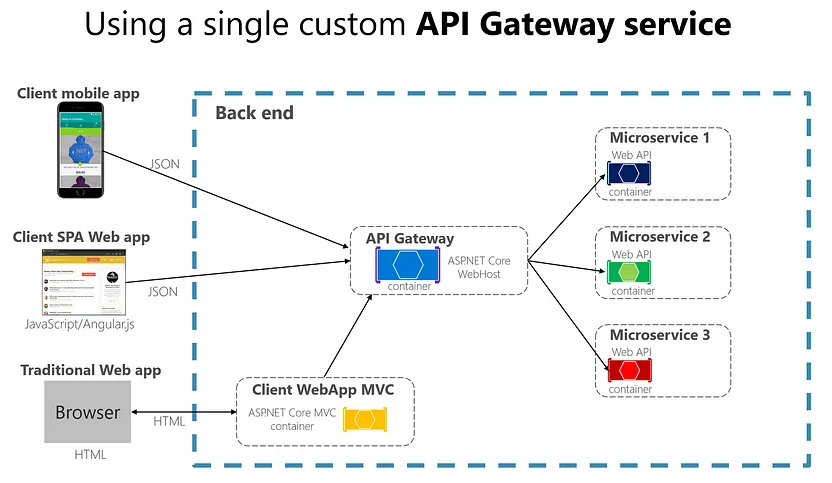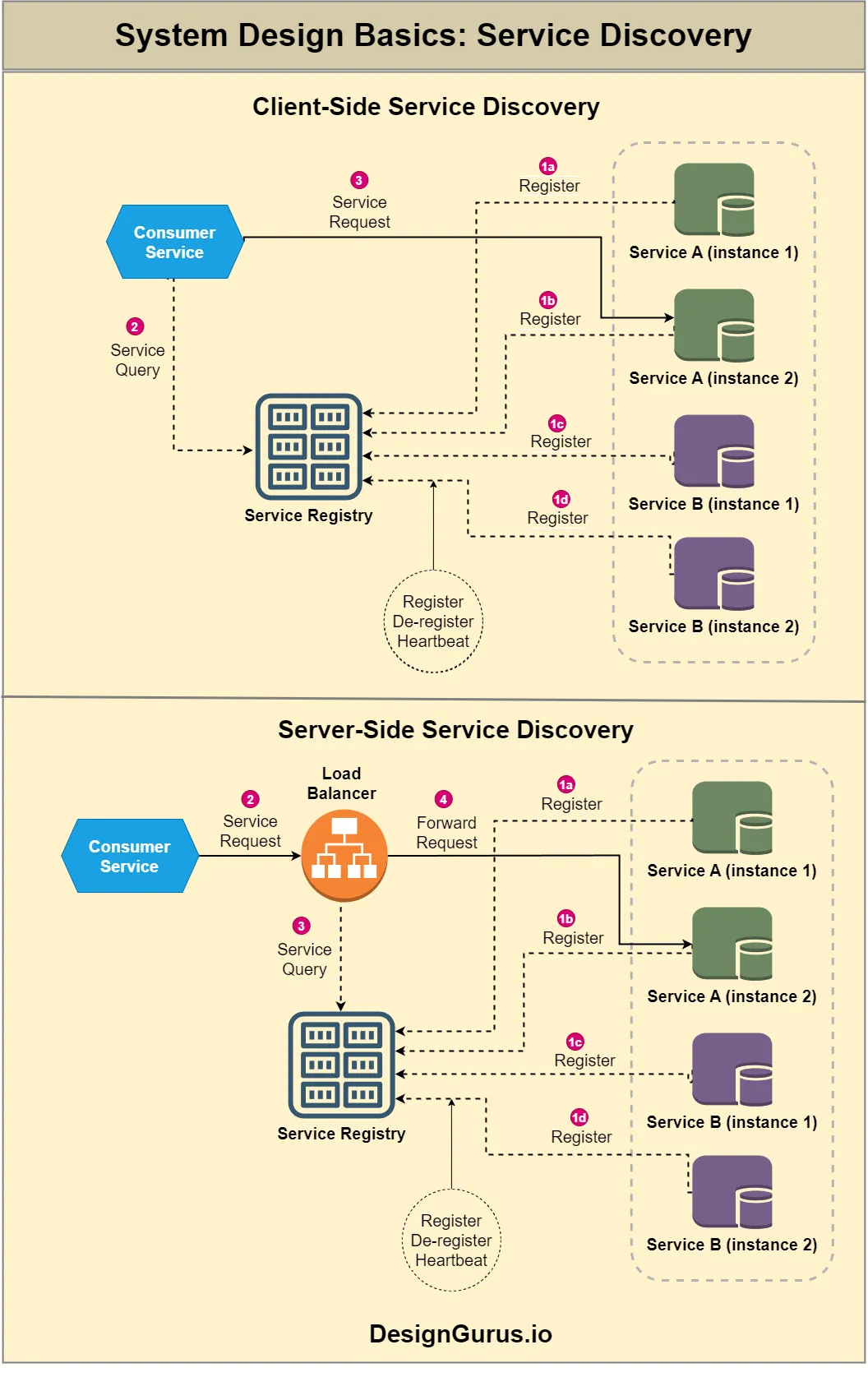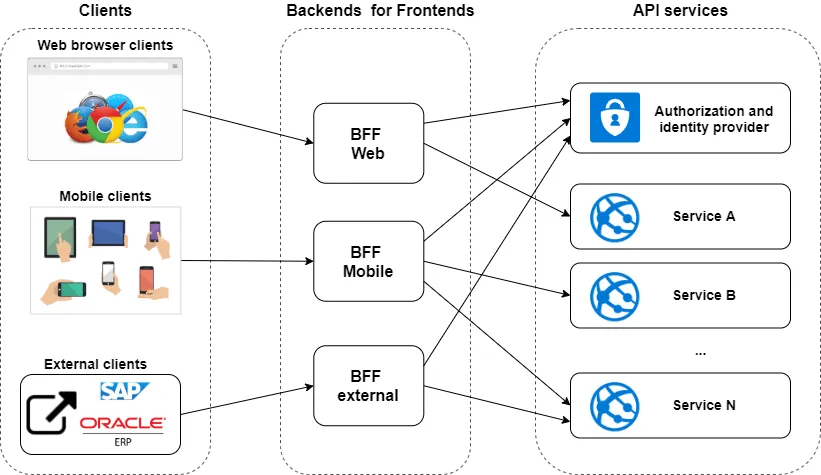Microservices architecture is a software development technique that breaks down a large application into smaller, manageable, and independent services. Each service is responsible for a specific functionality and communicates with others through well-defined APIs. This approach helps in achieving better scalability, maintainability, and flexibility of software systems.
1. API Gateway Pattern: The One-Stop-Shop for Microservices
Acting as a single entry point for all client requests, the API Gateway simplifies access to the microservices, offering seamless communication between clients and services.
First, it helps in aggregating responses from multiple microservices, reducing the number of round trips between clients and services. This results in improved performance and user experience. Second, it enables to implement cross-cutting concerns such as authentication, logging, and rate limiting at a single place, promoting consistency and reducing redundancy.
Imagine the convenience of having a central hub that takes care of all these responsibilities! According to a study by RapidAPI, 68% of developers who adopted API Gateway reported improved security and simplified management of their microservices.
Some popular API Gateway solutions include Amazon API Gateway, Kong, and Azure API Management. These tools provide a range of features, such as caching, throttling, and monitoring, to help in managing microservices efficiently.
In short, the API Gateway pattern is an essential component of a successful microservices architecture. By embracing this pattern, it can be ensured streamlined communication, enhanced security, and simplified management of the services.

2. Service Discovery Pattern: Navigating the Microservices Maze with Ease
The Service Discovery pattern is here to help to navigate the complex world of microservices with ease. This pattern allows services to find each other dynamically, ensuring smooth communication and reducing the need for manual configuration.
Why is Service Discovery crucial for a microservices architecture? As the system scales, managing the ever-changing service locations becomes increasingly challenging. With Service Discovery, services can automatically register and discover each other, promoting agility and flexibility in the system. In fact, 74% of developers who adopted Service Discovery reported increased efficiency in managing their microservices.
Service Discovery can be achieved through two main approaches: client-side discovery and server-side discovery. Client-side discovery involves the client querying a service registry to find the target service’s location, while server-side discovery relies on a load balancer to route requests to the appropriate service. Tools like Netflix Eureka, Consul, and Kubernetes offer built-in Service Discovery solutions to cater to specific needs.
In a nutshell, the Service Discovery pattern plays a pivotal role in maintaining a robust and adaptable microservices architecture. By implementing this pattern, it can easily manage and scale the services without breaking a sweat.

3. Circuit Breaker Pattern: Shield Microservices from Cascading Failures
Circuit Breaker pattern — the ultimate safeguard against cascading failures. This pattern monitors for failures and prevents requests from reaching a failing service, giving it time to recover and protecting the entire system from collapse.
In a microservices ecosystem, a single malfunctioning service can cause a domino effect, disrupting other services that depend on it. By using Circuit Breakers, you can isolate the faulty service and prevent further damage, ensuring the resiliency and stability of the system. A survey revealed that 77% of developers who utilized the Circuit Breaker pattern experienced a significant reduction in downtime.
Circuit Breakers can be easily implemented using libraries like Netflix Hystrix and Resilience4j. These libraries offer a range of features, such as fallback methods and monitoring, to help you manage and recover from failures efficiently.
In essence, the Circuit Breaker pattern is a must-have for building resilient and fault-tolerant microservices. By incorporating this pattern into the architecture, you can effectively shield the system from the adverse effects of service failures.
4. Load Balancing Pattern: Distribute Traffic Efficiently for High-Performance Microservices
Load Balancing pattern is the key to distributing traffic evenly across the services, ensuring optimal performance, and preventing service overload.
As the application grows, uneven traffic distribution can lead to service degradation or even failure. Load Balancing ensures that no single service becomes a bottleneck, resulting in improved performance and reliability. In fact, 81% of developers who adopted Load Balancing reported enhanced application responsiveness and reduced service downtime.
Load Balancing can be achieved through various algorithms, such as round-robin, least connections, and weighted round-robin. Each algorithm has its advantages and use cases, making it crucial to choose the right one for the system. Tools like NGINX and HAProxy offer powerful Load Balancing solutions, allowing to fine-tune the traffic distribution strategy.
In summary, the Load Balancing pattern is a vital component of a robust microservices architecture. By implementing this pattern, it can effectively manage traffic and ensure high-performance, scalable, and fault-tolerant services.

5. Bulkhead Pattern: Fortify Microservices with Advanced Fault Isolation
Bulkhead pattern isolates services and resources, ensuring that a failure in one service doesn’t bring down the entire system.
In a complex ecosystem, it’s crucial to prevent the domino effect of failures. By implementing Bulkheads, it can compartmentalize the services, ensuring that a malfunction in one area doesn’t cascade throughout the system. A study found that 73% of developers who adopted the Bulkhead pattern experienced a significant reduction in the impact of service failures on their applications.
Designing and implementing Bulkheads involves creating dedicated resources for each service, such as separate thread pools or database connections. This way, even if one service exhausts its resources, other services remain unaffected. Real-life examples of Bulkhead implementation include the AWS Lambda function resource allocation and connection pooling in databases.
In a nutshell, the Bulkhead pattern offers an advanced level of fault isolation, making it a critical component of resilient microservices architecture. Embracing this pattern can effectively minimize the impact of service failures and ensure the stability of the system.
6. CQRS Pattern: Boost Microservices Performance with Separation of Concerns
The CQRS (Command Query Responsibility Segregation) separates the read and write operations of the services, allowing to fine-tune each aspect independently for maximum efficiency.
In traditional architectures, combining read and write operations can lead to performance bottlenecks and increased complexity. CQRS can optimize each operation individually, resulting in improved performance and easier maintenance. Studies show that 78% of developers who adopted CQRS experienced enhanced system scalability and responsiveness.
Implementing CQRS involves segregating the services into two distinct parts: one for handling commands (write operations) and another for handling queries (read operations). This separation allows to apply different scaling, caching, and database strategies for each operation type. Popular frameworks, such as Axon and MediatR, offer built-in support for implementing the CQRS pattern.
In summary, the CQRS pattern is an effective approach to optimizing the performance and scalability of the microservices. Embracing this pattern can efficiently manage the read and write operations, ensuring a highly responsive and maintainable system.
7. Event-Driven Architecture Pattern: Empower Microservices with Real-Time Responsiveness
This pattern leverages events to trigger actions in services, enabling real-time responsiveness and promoting loose coupling between services.
By utilizing events as triggers, you can minimize direct dependencies between services, allowing for increased flexibility and easier system evolution. Research shows that 80% of developers who adopted this pattern experienced improved scalability and adaptability in their microservices.
Examples of event-driven systems include real-time notifications, data streaming, and IoT applications. Popular tools, such as Apache Kafka, RabbitMQ, and Amazon Kinesis, allow to implement this pattern effectively in microservices architecture.
In essence, the Event-Driven Architecture pattern offers a powerful way to enhance the responsiveness, flexibility, and scalability of microservices. Incorporating this pattern can create a dynamic system that adapts to changes in real-time.
8. Saga Pattern: Tackle Distributed Transactions with Confidence
The Saga pattern offers a reliable solution for handling distributed transactions, ensuring data consistency while maintaining the autonomy of the services.
In a microservices architecture, transactions often span across multiple services, making traditional ACID transactions unsuitable. The Saga pattern provides a way to manage these complex scenarios while preserving the benefits of microservices. Studies indicate that 76% of developers who implemented the Saga pattern experienced improved data consistency and reduced transaction complexity.
Implementing the Saga pattern involves breaking down a distributed transaction into a series of local transactions, each followed by an event or a message. If a local transaction fails, compensating transactions are executed to undo the completed steps, maintaining data consistency. Tools like Eventuate and Axon provide built-in support for implementing the Saga pattern in microservices architecture.
In summary, the Saga pattern is an indispensable tool for managing distributed transactions in a microservices ecosystem. Adopting this pattern can ensure data consistency and reduce transaction complexity while preserving the autonomy of the services.
9. Retry Pattern: Boost Microservices Resilience with Graceful Error Recovery
This pattern involves automatically retrying a failed operation, increasing the chances of successful execution and minimizing the impact of temporary issues.
In a microservices ecosystem, transient failures such as network hiccups or service timeouts are inevitable. The Retry pattern enables the services to recover gracefully from these issues, enhancing overall system stability.
The key to successful implementation lies in defining a suitable retry strategy. This strategy should include factors like the maximum number of retries, delay between retries, and any exponential backoff. Libraries like Polly, Resilience4j, and Spring Retry offer built-in support for implementing the Retry pattern in a microservice.
In a nutshell, the Retry pattern is an essential ingredient for building resilient microservices that can effectively recover from transient failures. Embracing this pattern can ensure a more stable and reliable system in the face of temporary issues.
10. Backends for Frontends Pattern (BFF): Optimize User Experience with Tailored Service Aggregation
This pattern involves creating dedicated backend services for each frontend, ensuring optimal performance and user experience tailored to each platform.
In a microservices architecture, a single backend service might not cater to the diverse requirements of different frontends. The BFF pattern enables to customize the backend services for each platform, enhancing performance and user experience. A study found that 82% of developers who adopted the BFF pattern reported improved user satisfaction and reduced development complexity.
To implement the BFF pattern, create separate backend services for each frontend (e.g., web, mobile, IoT), aggregating and adapting the data specifically for each platform’s requirements. Tools like GraphQL, Apollo Server, and Express.js can facilitate the creation of custom backend services for frontends.
In conclusion, the BFF pattern is a powerful approach to optimizing the user experience across multiple platforms in a microservices ecosystem. Adopting this pattern can tailor the services to each platform’s needs, ensuring top-notch performance and user satisfaction.

11. Sidecar Pattern: Supercharge Microservices with Modular Functionality
This pattern allows you to attach additional components to the services, providing modular functionality without altering the core service itself.
In a microservices architecture, maintaining service independence is crucial. The Sidecar pattern enables you to add new features or cross-cutting concerns without affecting the main service, preserving modularity and maintainability. Research shows that 77% of developers who implemented the Sidecar pattern experienced increased agility and reduced development complexity.
Implementing the Sidecar pattern involves deploying a separate container alongside the main service container. This “sidecar” container handles specific tasks such as logging, monitoring, or security, allowing the main service to focus on its core functionality. Examples of Sidecar implementation include the Envoy proxy in a service mesh and the Fluentd logging sidecar.
In summary, the Sidecar pattern is an effective way to extend the microservices functionality while preserving their modularity and independence. Embracing this pattern can enhance services with ease, ensuring a scalable and maintainable system.
12. Strangler Pattern: Transform Monolith into Microservices with Confidence
This pattern enables you to gradually replace monolithic system with microservices, ensuring a smooth and risk-free transition.
Migrating from a monolithic architecture to microservices can be challenging and risky. The Strangler pattern allows for incremental replacement, minimizing downtime and risk while maintaining business continuity. Studies reveal that 81% of developers who used the Strangler pattern experienced a smoother migration with fewer issues.
To implement the Strangler pattern, start by identifying a specific functionality within the monolithic system. Then create a new microservice to handle that functionality and redirect requests to the new service using an API gateway or proxy. Over time, repeat this process for other functionalities until the entire monolith is replaced with microservices.
In short, the Strangler pattern is an invaluable tool for transforming a monolithic system into a microservices architecture with confidence. Following this pattern can ensure a smooth and risk-free migration.
Take a look at Grokking Microservices Design Patterns to master these microservices design patterns for designing scalable, resilient, and more manageable systems. Source
